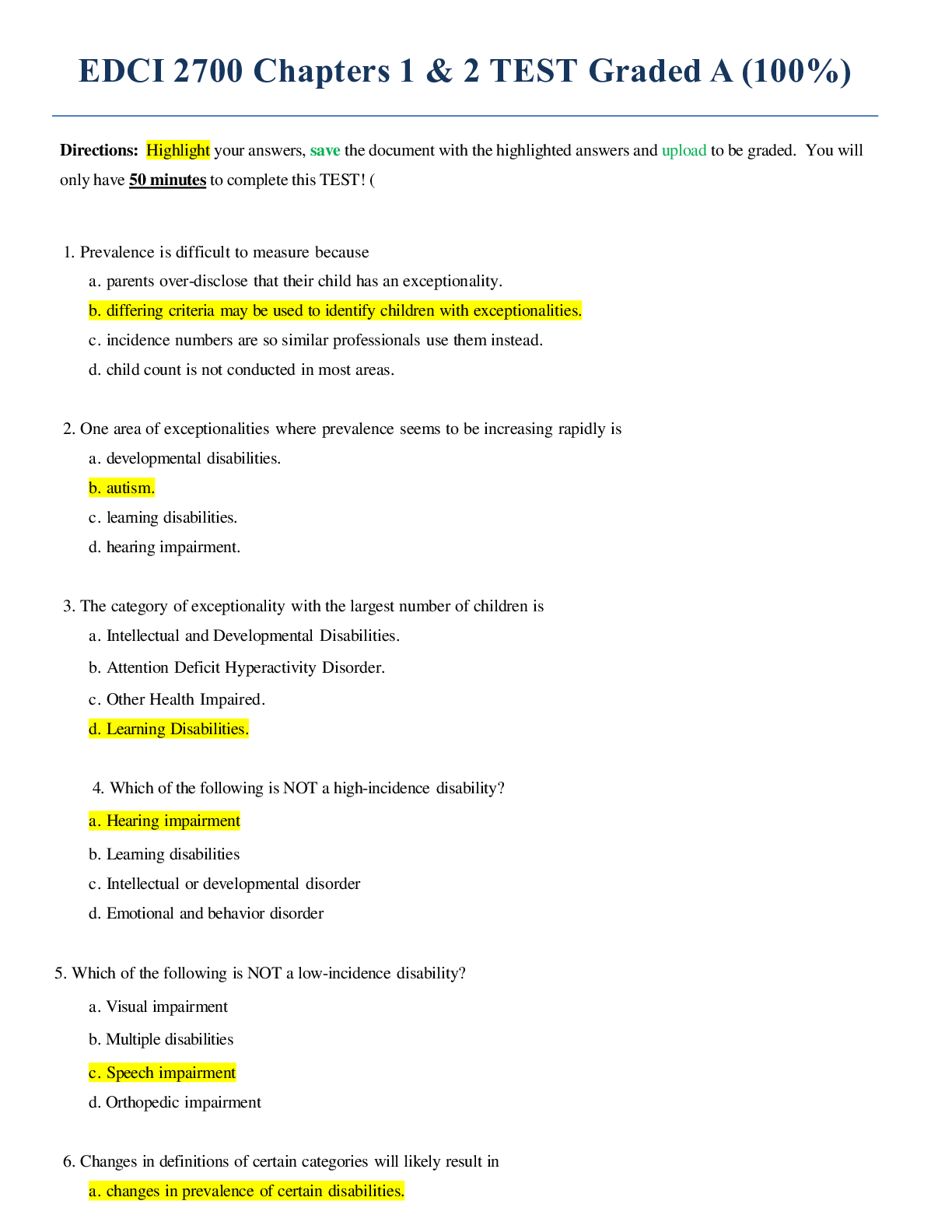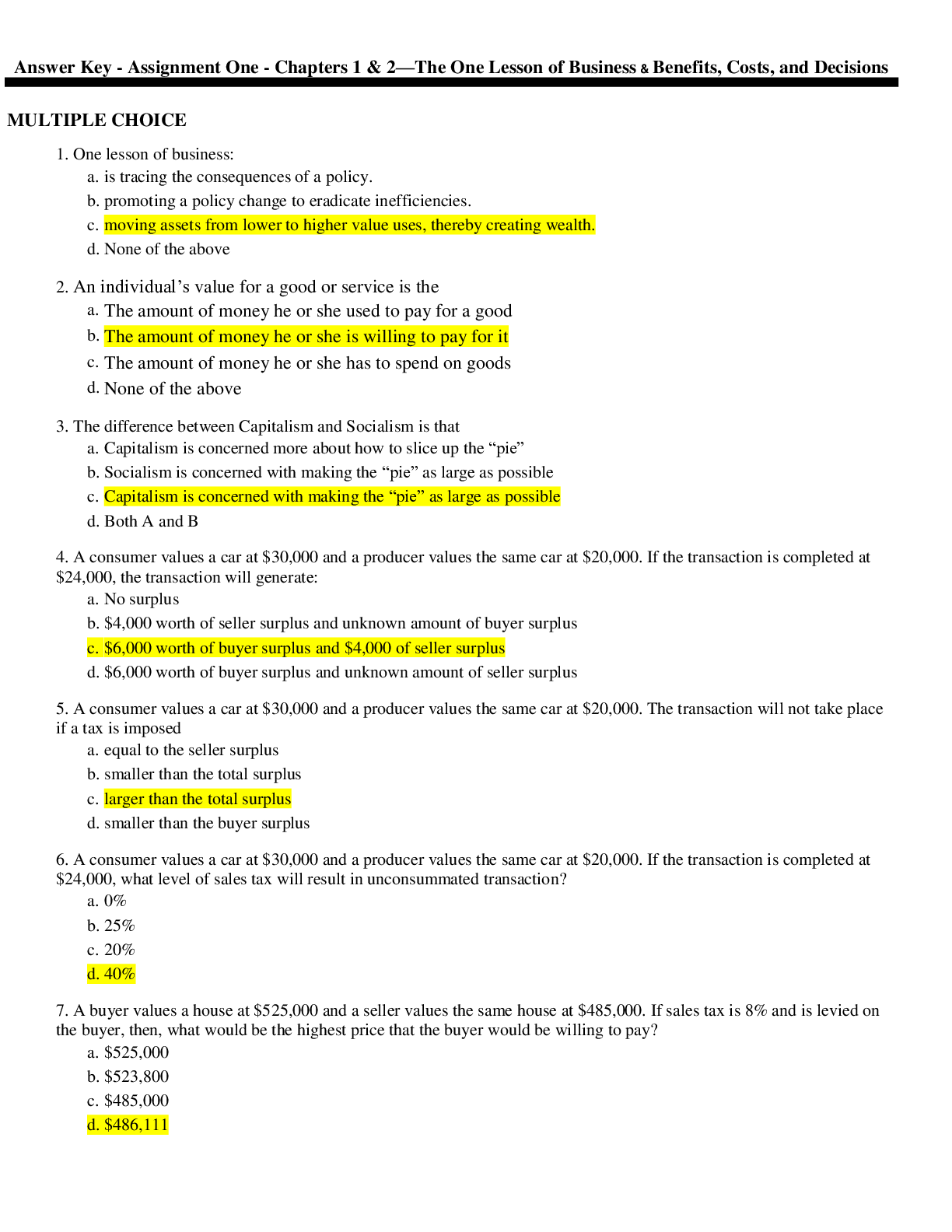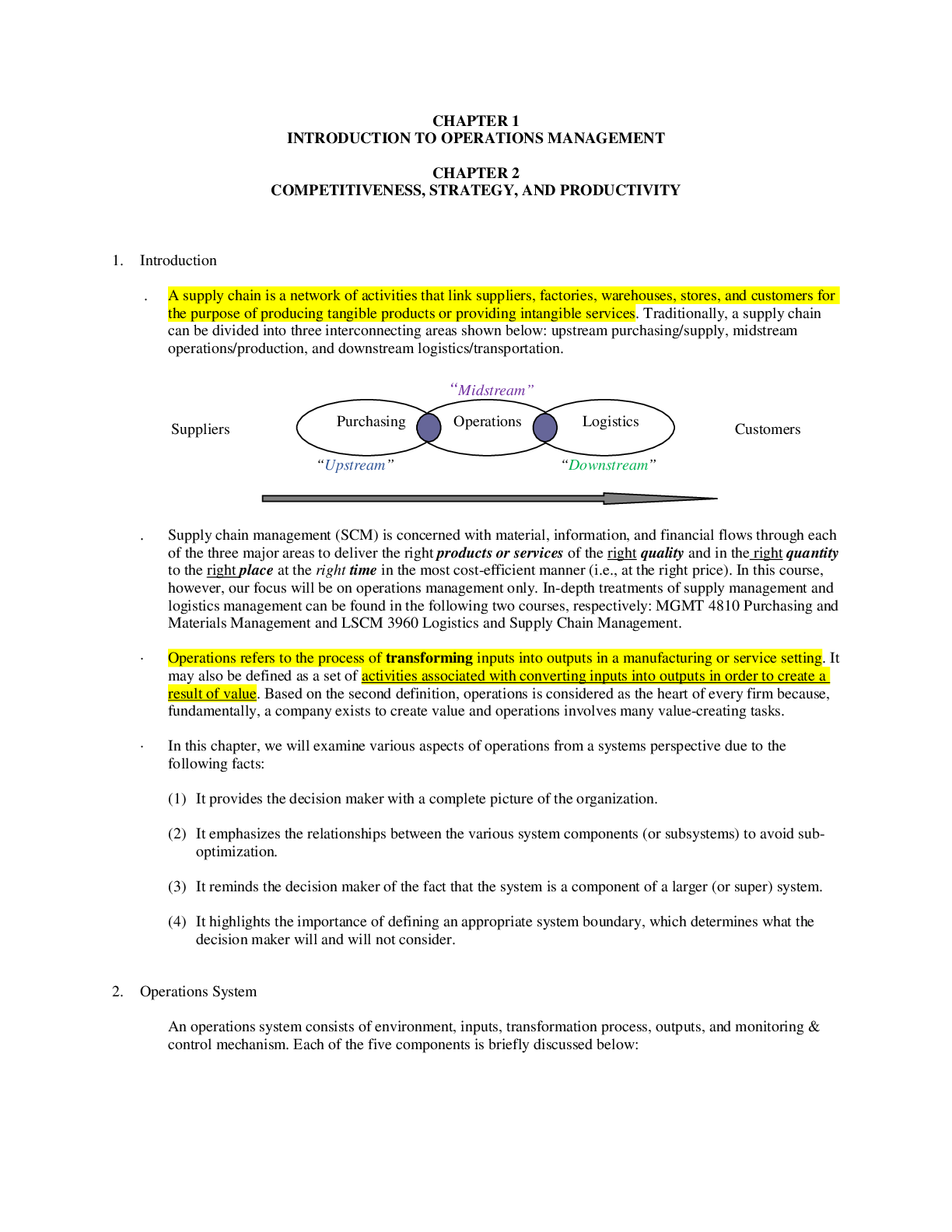*NURSING > QUESTIONS & ANSWERS > EDCI 2700 Chapters 1 & 2 TEST Graded A (100%) (All)
EDCI 2700 Chapters 1 & 2 TEST Graded A (100%)
Document Content and Description Below
Directions: Highlight your answers, save the document with the highlighted answers and upload to be graded. You will only have 50 minutes to complete this TEST! ( 1. Prevalence is difficult to ... measure because a. parents over-disclose that their child has an exceptionality. b. differing criteria may be used to identify children with exceptionalities. c. incidence numbers are so similar professionals use them instead. d. child count is not conducted in most areas. 2. One area of exceptionalities where prevalence seems to be increasing rapidly is a. developmental disabilities. b. autism. c. learning disabilities. d. hearing impairment. 3. The category of exceptionality with the largest number of children is a. Intellectual and Developmental Disabilities. b. Attention Deficit Hyperactivity Disorder. c. Other Health Impaired. d. Learning Disabilities. 4. Which of the following is NOT a high-incidence disability? a. Hearing impairment b. Learning disabilities c. Intellectual or developmental disorder d. Emotional and behavior disorder 5. Which of the following is NOT a low-incidence disability? a. Visual impairment b. Multiple disabilities c. Speech impairment d. Orthopedic impairment 6. Changes in definitions of certain categories will likely result in a. changes in prevalence of certain disabilities. b. the use of census data instead of school counts. c. better counting procedures. d. the cross-checking of school counts by auditing teams. 7. The shift away from the medical model of defining exceptionality is the result of a. increasing recognition of the influence of the environment. b. increasing use of technology. c. increasing emphasis on parent advocacy. d. increasing concern regarding cultural bias. 8. The ecological approach to intervention focuses on a. direct remediation of developmental delays. b. the creation of family support services. c. modification of the "environment" around the child. d. altering community expectations. 9. An ecological approach is used a. only as a medical model of understanding exceptionality and the child's limitations. b. to incorporate the child’s family, school, and community into his/her learning environment. c. mainly with children with behavior problems to modify the environment. d. to determine which component of the IPM works the best with certain exceptionalities. 10. The family-centered model focuses on a. the etiology of the disability. b. the parents delivering the intervention. c. the strengths in the child and family. d. the parental supportive system. 11. The major goal for the family-focused approach is to a. give the parents the financial support that they need to provide for their child. b. help parents become more autonomous and less dependent on professionals. c. tell the family how to raise their child. d. give parents respite care when needed. 12. The increasing interest in the family as a focus for intervention is based on which of the following assumptions? a. Intervention for young children with exceptionalities should not be the concern of the public schools. b. Families are capable of providing the supports needed by children with exceptionalities until they reach school age. c. Involving and supporting families is likely to be a more powerful intervention than focusing exclusively on the child. d. Only minimal intervention is needed for young children with exceptionalities until they are school age. 13. The movement toward an early intervention model makes which of the following more important? a. The family environment b. The medical model c. The theoretical model d. Response to intervention 14. Which of the following is NOT true of parents' roles as collaborative members of their child's multidisciplinary team? a. They can provide professionals with important information about their child. b. They can take an active role in teaching their child outside the classroom. c. They can reinforce learning that has taken place in the classroom. d. They can complete assignments on behalf of their child. 15. Which of these emotions do parents usually experience first when their child is diagnosed with a serious disability? a. Anger b. Guilt c. Shock d. Frustration 16. The idea of educating every child to achieve his or her greatest potential is a relatively recent one. a. True b. False 17. Which of the following was NOT a cause leading to federal intervention in the education of children with exceptionalities? a. Increased services for children with exceptionalities caused a personnel shortage. b. There were discrepancies in what states offered educationally to children with exceptionalities. c. The field of special education was not clearly defined. d. States were spending too much time and money on the education of children with exceptionalities. 18. According to the authors of your text, the influence of the school on how exceptional children adjust to life a. is greater than the influence of their homes and families. b. is not a major factor. c. is one of many important environmental influences, including home and family. d. can be measured using standardized tests. 19. It is considered a violation of federal law for an educator to ignore federal regulations regarding the education of children with exceptionalities. a. True b. False 20. Which of the following was a barrier to the creation of federal legislation regarding the education of children with exceptionalities? a. Parents groups were more interested in lobbying individual states for change instead of forming a national coalition. b. A strong federal role in education violated the American tradition of making education the responsibility of states. c. There was no scientific recognition of the role of educational intervention in the education of exceptional children. d. Educators disliked the idea of legal regulation of their teaching and distrusted any federal intervention. 21. Which of the following is NOT a right given to parents by Public Law-94-142? a. They may access their child's educational records. b. They can participate in the development of the IEP. c. They can request a due process hearing. d. They can control the teacher and school their child is assigned. 22. The set of procedures specified in Public Law 94-142 that allow parents to call a hearing when they do not agree with the school's plan for their child, retain an examiner outside the school system, or to take other actions is called a. due process. b. the least restrictive environment. c. parental participation. d. zero reject. 23. The concept of zero reject means that a. school districts have the option to refuse services if they currently do not offer those services. b. schools can decide to reject students who need services if the cost is considered too high. c. schools are obligated to provide a free and appropriate public education to all students. d. schools can decide whether they want to provide services to an exceptional student. 24. Which of the following is characteristic of nondiscriminatory evaluation as defined by the Education for All Handicapped Children Act? a. The student must be evaluated with a group of students from the same cultural background. b. The student must be reevaluated every month. c. The student must be examined by a person from the same culture. d. Evaluation must take place with tests appropriate to the student's cultural and linguistic background. 25. The term least restrictive environment refers to a. serving all students with disabilities in the regular classroom. b. assessing children within their home environment. c. focusing special education services on community-based goals. d. providing services in a setting that is as close to normal as possible. 26. One of the innovations produced by the Education for All Handicapped Children Act (PL 94-142) is the requirement that every child with a disability a. receive speech therapy. b. receive physical therapy. c. have an individual tutor. d. have an individualized education program. 27. Public Law 99-457 extended the benefits of Public Law 94-142 to a. preschool children. b. children with severe and profound disabilities. c. children with autism. d. children with physical disabilities. 28. IDEA 2004 requires transition services, which include support for a. postsecondary education, independent living, and vocational training. b. preschool education, daycare, and job training. c. independent living only. d. the challenge of caring for aging parents. 29. Which piece of federal legislation provides access to services for children who may not be judged eligible for services under IDEA 2004? a. No Child Left Behind b. Education for All Handicapped Children Act c. Section 504 of the Rehabilitation Act d. American Recovery and Reinvestment Act 30. PL 107-110, No Child Left Behind, sets a. the standards for all special education students. b. unrealistic expectations for some students with disabilities. c. the standards of 75 percent proficiency on the part of students and schools. d. the short-term objectives on the student's IEP. [Show More]
Last updated: 1 year ago
Preview 1 out of 6 pages

Reviews( 0 )
Document information
Connected school, study & course
About the document
Uploaded On
May 01, 2020
Number of pages
6
Written in
Additional information
This document has been written for:
Uploaded
May 01, 2020
Downloads
0
Views
48




















.png)



.png)

.png)


.png)
.png)

.png)

